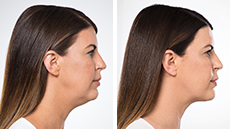
Non-invasive Kybella may improve your neckline
Non-invasive aesthetic procedures have come a long way in the last ten years. The American Society of Plastic Surgery’s yearly statistics continue to demonstrate strong demand for procedures such as neuromodulators (Botox and Dysport), and hyaluronic acid filler agents (Juvederm, Voluma, Restalyn). Recently, non-invasive contouring systems that perform the techniques of cryolipolysis, such as Cool Sculpting and radiofrequency skin-tightening Ultherapy, have emerged in the marketplace. Now Allergan has added Kybella to the mix as a non-invasive injectable material to dissolve fat under the chin.

The key to success with these treatments is consulting a comprehensive center that offers a full array of non-invasive and surgical options, and will direct you to the ideal treatment modality for your unique circumstances. Just as with any medical and surgical procedure, there are appropriate candidates and patients with contraindications.
The most important step to avoid dissatisfaction is to be evaluated by a physician who is properly trained to perform comprehensive evaluation and care for all patients with a particular aesthetic concern.
Board-certified plastic surgeons have the most comprehensive education and background experience to correctly evaluate your anatomy and determine which treatments will yield the best outcomes. The statement “if all you have is a hammer the whole world is a nail” rings true for medical spas and dermatologist offices which only have one option, such as Cool Sculpting or Kybella. Just because a treatment option is non-invasive does not mean it is inexpensive. If you factor in the cost of multiple treatments, it may be as expensive as surgery and still fall short of expectations.
When is Kybella the right choice?
With the current status of the injectable form of deoxycholic acid (Kybella) the ideal candidate must have reasonably tight skin with only mild to moderate adipose excess in the submittal and chin neck angle. The patient should not have a significant mandibular jaw discrepancy with the midface or have a particularly steep mandibular plain angle.
When is Kybella the wrong choice?
Any patient with lax skin of the neck or a significant deflation of the neck related to weight loss with demarcated platysmal bands is not a candidate. Taking away fat in this circumstance only worsens the deformity. Any patient with a deep underbite and a small chin with a very oblique chin-neck angle should also avoid Kybella. Deoxycholic acid is mostly created to dissolve fat but does produce some inflammation with the caustic material to encourage collagen production and skin retraction. Skin excess with an oblique chin neck angle and recessed chin will not yield overwhelming positive results.
Instead of Kybella, the better option is placement of a chin implant (genioplasty) with aggressive liposuction to encourage skin retraction. A middle facial third with significant skin excess and deflation combined with loose-hanging skin with platysmal bands is best treated with a corset platysmaplasty in conjunction with a neck/face lift.
Non-invasive aesthetic procedures can be a wonderful adjunct to helping people age gracefully with limited down time. Kybella in the right situation may improve necks and make people happy with the results.
Avoid being pushed into this option without a thorough three-dimensional analysis of your face to determine if it’s right for you. Nothing is more frustrating than spending a great deal of money and not realizing your desired results. Even with surgery, some deformities may not be able to be corrected. Take advice from a board-certified plastic surgeon to maximize your goals and to feel good in your own skin.